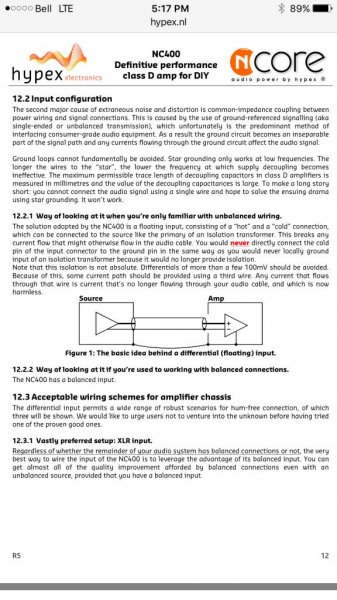As much as I have respect for Roger, this is a prime example of how this topic is misunderstood by even engineers. When we talk about noise, there are many versions of it. One for example is noise being picked up by the cable. In this discussion, we are *not* talking about that noise. Nor are we talking about noise inside of your electronics.
What we are talking about is that by mere fact that two power cords in two separate pieces of equipment creates two different ground potentials (voltages), by definition if you hook those two chasses together, current moves between them. If you then proceed to use unbalanced connection, this current becomes part of your signal. And because it runs at AC mains frequencies, it translates into hum.
This is *totally* induced noise by the user/system. It is on top of any and all other sources of noise. Its reason for existence cannot be eliminated. No matter what you do, the two chassis will be at different voltages. It is a problem created when we went from all-in-one systems to components. This problem was recognized and balanced connection were invented to eliminate it (plus other benefits I won't get into).
No goodness to a user comes from such a connection scheme. You are forcing the system into producing noise. Why on earth would you want to do that? You can't with a straight face.
Now if you are a designer/manufacturer, you have many reasons to want to avoid building a fully differential system. Such is life in mass market where component cost is everything. But in a $20,000+ amplifier or component? No way do I tolerate such compromises.
Given me both options and let me choose if it is not the cost that took balanced out of the system. Otherwise the arrow points directly at cost cutting. Or lack of understanding of the problem here which unfortunately is prevalent.
I say if there is one topic engineers like to forget about when they leave school is this one. It makes their heads hurt when they are taught the theory and walk out confusing all manner of grounding, transmission, emission, etc. This is behind so many bad designs and bad advice online. I myself had to relearn all of this.
That's absolutely not true, you do not have a correct picture of what is happening in a single ended system. Your whole post is misinformation... It IS true that the ground on single ended cables carries a lot more than just the return signal, but under normal circumstances it doesn't couple to the signal, otherwise single ended systems would be completely unuseable.
The truth is, many people happily own and listen to single ended systems with minimal noise. One of my systems is ridiculously quiet, you can't hear noise from a 102 dB speaker with your ear INSIDE THE HORN. And that's with separate components, a tube pre and amp, that I built myself using simple star grounding.
A far larger issue wrt noise is the typically excessive gain of modern systems, but with single ended vs balanced, both can be done right, it's the implementation that's important much like most things in audio. Whenever someone makes a blanket statement "XXX is always better" you know it's information you can safely disregard 99% of the time.
Another data point is Odyssey, who makes amps that won TAS best product of the year award two years running, he recommends single ended connections. Amir, there are just too many people who manage to do exactly what you are saying is impossible, and in fact PREFER single ended systems. Your attitude that they just don't know better (and you do) is a bit ridiculous. As far as I can see, you are the one who is mistaken on this topic, and you're contradicting a lot of folks who actually design and build quality gear. Your ideas simply don't match up with reality.
Not only that, balanced systems were not invented to deal with SCIN issues, they were invented to deal with cable interference issues, hence the shielded, twisted pair standard. Balanced components are not as immune to SCIN as you seem to think either.









